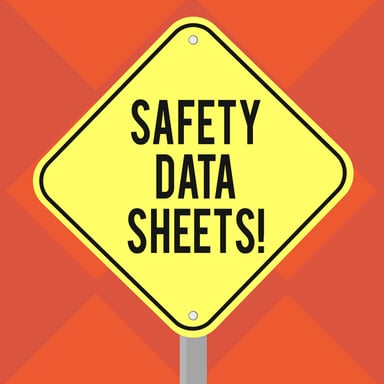When a bulk chemical transport provider is contacted to transport a chemical product, the first thing the provider will ask for is the chemical’s Safety Data Sheet (SDS; formerly MSDS or Material Safety Data Sheet). The information included on the SDS is invaluable in helping the logistics provider understand just what exactly is being shipped (and, thus, how to ship it).
In this article, we’ll examine Safety Data Sheets for chemical products: why they matter, what they include, and how that information relates to product transportation.
Why do Safety Data Sheets matter?
 SDSs are required by OSHA under its Hazard Communication Standard. This Standard requires chemical manufacturers, distributors or importers to provide specific information about chemical products to downstream users. This information is essential to bulk freight shipments for the following reasons.
SDSs are required by OSHA under its Hazard Communication Standard. This Standard requires chemical manufacturers, distributors or importers to provide specific information about chemical products to downstream users. This information is essential to bulk freight shipments for the following reasons.
- Safety and Health Protection: The SDS contains essential information on the chemical's hazards, including toxicity, fire hazards, and potential health effects. This information is critical for protecting the health and safety of all personnel involved in the shipping, handling, and unloading processes.
- Regulatory Compliance: Transporting hazardous materials is highly regulated by various national and international regulations. The SDS helps ensure that the shipment complies with these regulations by providing necessary hazard classifications, labeling requirements, and safety measures.
- Emergency Response: In the event of an accident, spill, or exposure, first responders and emergency personnel rely on the SDS for critical information on the chemical's properties, including recommended emergency procedures, fire-fighting measures, and spill cleanup methods.
- Environmental Protection: The SDS provides information on the environmental impact of the chemical, including precautions for preventing release to the environment and specific cleanup procedures. This is vital for minimizing environmental damage in case of leaks or spills during transportation.
- Proper Handling and Storage: For the safe handling and storage of liquid bulk products, the SDS provides instructions on appropriate practices, such as suitable container types, recommended personal protective equipment (PPE), and conditions for safe storage. This information helps prevent accidents and ensures the stability and integrity of the product during transport.
What’s on the SDS – a detailed look
The information on the Safety Data Sheet is broken up into the following 16 sections of the Safety Data Sheet.
Section 1: Identification
What’s included:
- Name of chemical, including other names by which the chemical is known
- Recommended uses
- Appropriate contact information (i.e., supplier, manufacturer, importer)
Transport ramifications:
- This section will tell the logistics provider what type of chemical it is dealing with (e.g., an oil, wax, glycol, etc.) and thus what basic type of tanker or trailer is required.
Section 2: Hazard Identification
What’s included:
- Chemical classification (e.g., flammable liquid)
- Hazard and precautionary statements
- Description of ingredients with “unknown acute toxicity” as well as the percentage of those ingredients included in the chemical mixture
Transport ramifications:
- If the chemical being shipped is hazardous, this places restrictions on the tanker or trailer (and related equipment) that can be used to haul it. It may also limit the number of carriers that are qualified to handle it.
Section 3: Composition/Information on ingredients
What’s included:
- A listing of the ingredients contained in the chemical product (including the concentration of these ingredients)
- Chemical Abstracts Service (CAS) number and other unique identifiers.
- Listing of impurities and stabilizing additives
- A statement regarding trade secrets (if applicable; the chemical’s ingredients and/or concentration of ingredients may be claimed to be a trade secret by the manufacturer)
Transport ramifications:
- As with Sections 1 and 2, the information in this section will further determine what type of tank will be used. Some ingredients do not ‘play nice’ with specific prior materials, and the logistics provider will need to carefully match the chemical to the appropriate equipment. For instance, the makeup of the chemical may require a specific grade of stainless steel, or the product may be best suited for another type of tank such as rubber-lined, polyethylene or plastic.
Section 4: First-Aid Measures
What’s included:
- Description of care to be given in the event of chemical exposure. This includes descriptions of symptoms as well as first-aid and immediate care recommendations.
Transport ramifications:
- This is important information that should be heeded by drivers and personnel at loading and unloading sites should exposure occur.
Section 5: Fire-Fighting Measures
What’s included:
- Recommendations for handling a fire in the event one should occur, including extinguisher equipment that is appropriate/inappropriate.
Transport ramifications:
- This information should be heeded by drivers and personnel at loading and unloading sites.
Section 6: Accidental Release Measures
What’s included:
- Recommendations for responding to spills, leaks or releases of the chemical. This includes procedures related to cleanup and containment, and measures to protect people, property and the environment.
Transport ramifications:
- This information enables drivers and onsite personnel to effectively respond to a situation in which a tank may be compromised and a chemical product is released. The loading and unloading facilities will typically have their own protocols for dealing with such events. Law enforcement or CHEMTREC (a chemical response organization with 24/7 support) may be contacted for additional support.
Section 7: Handling and Storage
What’s included:
- Safe handling practices and safe storage guidelines
Transport ramifications:
- This section provides guidelines for storing the product in the tanker or trailer (e.g., container must be closed tightly; container must be dry and well ventilated).
Section 8: Exposure Controls/Personal Protection
What’s included:
- Exposure limits for all workers who come into contact with the chemical. These include OSHA Permissible Exposure Limits (PELs), American Conference of Governmental Industrial Hygienists (ACGIH) and Threshold Limit Values (TLVs).
- Recommendations for personal protective equipment that should be worn by workers who may encounter the chemical
Transport ramifications:
- This precautionary information should be heeded by drivers and all personnel that may come into contact with the chemical.
Section 9: Physical and Chemical Properties
What’s included:
- Identification of physical and chemical properties (e.g., appearance, flammability/explosive limits, odor, vapor pressure, pH, melting point, boiling point, viscosity).
Transport ramifications:
- Of all the important properties included in this section, the ones that logistics providers are especially concerned with are odor, pH, melting point and whether or not the product is hazmat.
- Odor: Some suppliers prefer prior products that have little-to-no odor to them. So, before a tank or trailer is selected for transport, the shipper may want to see the SDS sheets of the prior chemicals that shipped in the tank or trailer. Depending on the odor characteristics of those chemicals, a tank or trailer may be deemed unfit to carry the product in question – even if it is washed thoroughly prior to transport.
- pH: Many carriers want to avoid chemicals that are acidic as they can damage many types of tanks and equipment.
- Melting point: If there is a product temperature requirement, logistics providers will want to clearly understand the melt point (aka “solidification point”) of that specific material.
- Hazmat: Hazardous chemicals will have specific transportation requirements related to the class of chemical being hauled.
Section 10: Stability and Reactivity
What’s included:
- Description of the chemical’s stability information and reactivity hazards.
Transport ramifications:
- Stability: this section explains the chemical’s shelf life.
- Reactivity: this section tells logistics providers what happens when a chemical comes into contact with other chemicals. As with odor, this informs what chemicals can or cannot have been previously stored in the tank or trailer (i.e., “incompatible prior products”).
Section 11: Toxicological Information
What’s included:
- Detailed information of potential health effects associated with exposure.
- Indication as to whether the chemical is listed as a carcinogen by the National Toxicology Program (NTP) Report on Carcinogens, International Agency for Research on Cancer (IARC) Monographs or by OSHA.
Transport ramifications:
- Similar to Section 8, this information guides drivers and loading/unloading site personnel in dealing with chemical exposure, should it occur.
Section 12: Ecological Information (non-mandatory)
What’s included:
- Descriptions of the potential effects of the chemical on the environment, if it were to be released.
Transport ramifications:
- This information guides drivers and onsite personnel in assessing the impact of a chemical release and informs containment efforts.
Section 13: Disposal Considerations (non-mandatory)
What’s included:
- Guidance on disposal and/or recycling of the chemical and its containers.
Transport ramifications:
- This information informs chemical disposal practices for onsite personnel.
Section 14: Transport Information (non-mandatory)
What’s included:
- Classification information for shipping/transporting the chemical.
- Includes transport hazard class(es) and International Bulk Chemical Code (IBC Code).
Transport ramifications:
- This information informs logistics providers of regulations associated with the chemical, and also informs providers as to the chemical/hazmat placards that need to be placed on the tank or trailer during transport.
Section 15: Regulatory Information (non-mandatory)
What’s included:
- Identification of health, safety and environmental regulations not listed anywhere else on the SDS.
Transport ramifications:
- This additional information may augment or expand upon many of the previous sections of the SDS.
Section 16: Other Information
What’s included:
- Indication of when the SDS was created and when the last revision(s) was made.
Transport ramifications:
- If there have been changes made to the SDS that aren’t clearly explained in this section, the logistics provider may want to follow up with the shipper to understand exactly what changes were made and when.
Turn to a true freight expert for chemical shipping
While the SDS is an invaluable resource in planning a chemical shipment, it’s only part of the story. You need a true transportation expert to disseminate that information and apply it to the equipment, carriers and drivers that will haul it. With over 30 years of chemical transportation experience, Bulk Connection is that expert. No matter what chemical you’re shipping, chances are we’ve handled it – and handled it often. To learn more about our chemical transportation services, contact Bulk Connection today.





